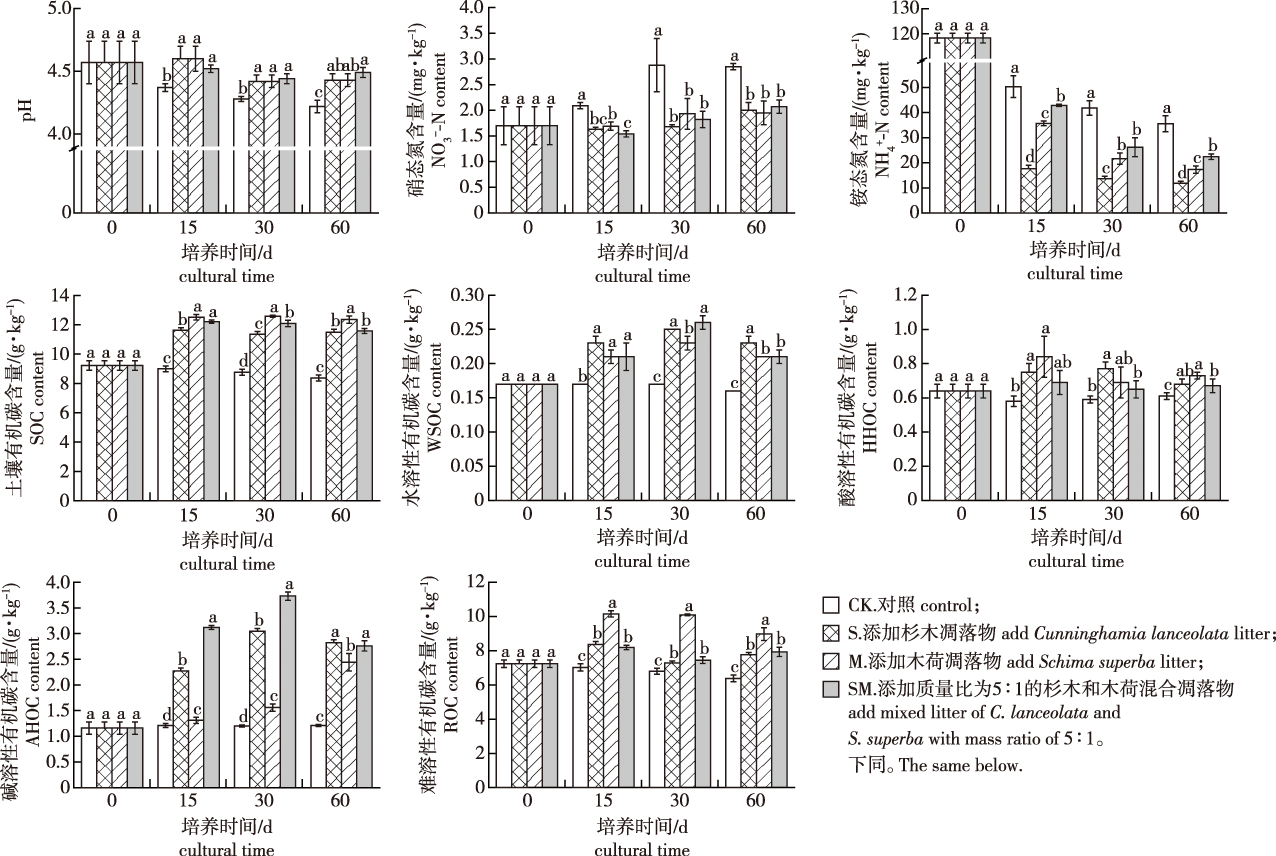 PDF(2560 KB)
PDF(2560 KB)


杉木与木荷凋落物分解对杉木人工林土壤碳氮含量和酶活性的影响
周梦田, 刘莉, 付若仙, 李孝刚
南京林业大学学报(自然科学版) ›› 2024, Vol. 48 ›› Issue (5) : 131-138.
 PDF(2560 KB)
PDF(2560 KB)
 PDF(2560 KB)
PDF(2560 KB)
杉木与木荷凋落物分解对杉木人工林土壤碳氮含量和酶活性的影响
Effects of litter decomposition of Cunninghamia lanceolata and Schima superba on soil carbon contents, nitrogen contents and enzyme activities in Cunninghamia lanceolata plantations
【目的】凋落物回归影响着杉木(Cunninghamia lanceolata)人工林土壤碳氮循环,是杉木人工林可持续经营和土壤地力维持的重要过程。通过分析添加杉木与木荷(Schima superba)凋落物处理下土壤碳氮含量和酶活性的变化特征,为杉木人工林近自然化改造及林分管理提供依据。【方法】以30年生杉木人工林土壤为研究对象,分别添加杉木凋落物(S)、木荷凋落物(M)以及杉木与木荷凋落物混合物(SM),混合质量比例设置为m(杉木):m(木荷)=5:1。通过60 d室内培养,测定不同处理土壤中铵态氮( -N)、硝态氮( -N)、土壤有机碳(SOC)、水溶性有机碳(WSOC)、酸溶性有机碳(HHOC)、碱溶性有机碳(AHOC)、难溶性有机碳(ROC)含量及酶活性[β-葡萄糖苷酶(GC),β-N-乙酰氨基葡萄糖苷酶(NAG),多酚氧化酶(PPO),亮氨酸氨基肽酶(LAP)]。基于单因素方差分析和冗余分析方法,研究不同处理下土壤碳氮含量与土壤酶活性的关系,探讨添加不同凋落物对杉木人工林土壤碳氮含量及酶活性的影响。【结果】①SM处理的土壤腐殖化程度高于添加单一凋落物的;在添加单一凋落物的处理中,M处理的土壤腐殖化程度较低,土壤中ROC含量占比较高。②处理至15和30 d时,S处理土壤的GC、NAG、PPO酶活性显著高于M处理土壤的;SM处理的可显著提高土壤GC和NAG活性。③相关分析表明,土壤中AHOC含量与GC活性呈极显著正相关;NAG活性与WSOC含量呈极显著正相关,与 -N含量呈极显著负相关;而PPO活性与 -N含量呈极显著负相关,与ROC、HHOC含量呈极显著正相关(P<0.01)。【结论】添加不同凋落物对杉木人工林土壤碳氮含量及酶活性产生显著影响。与添加木荷凋落物相比,添加杉木凋落物的土壤腐殖化程度较高,与碳氮循环相关的酶活性较高;与添加单一凋落物相比,添加杉木木荷凋落物混合物更有利于土壤腐殖化程度的提升,提高土壤碳氮转化酶活性,进而有利于杉木人工林土壤碳氮循环。
【Objective】Litter regression can affect the soil carbon and nitrogen cycle, which is an important process of sustainable management and soil fertility maintenance in Chinese fir(Cunninghamia lanceolata)plantations. The changes in soil carbon content, nitrogen content, and enzyme activity under the treatment of adding C. lanceolata and Schima superba litter were analyzed to provide the basis for nature-approximating transformation and stand management of C. lanceolata plantations.【Method】In the present study, 30-year-old C. lanceolata plantation soil was treated with C. lanceolata litter (S), S. superba litter (M), and a mixture of C. lanceolata and S. superba litter (mixed at a m (S):m (M)=5:1, SM). After 60 days of incubation, the content of ammonium nitrogen ( -N), nitrate nitrogen ( -N), soil organic carbon (SOC), water soluble organic carbon (WSOC), hydrochloric acid hydrolyzed organic carbon (HHOC), alkaline-hydrolyzable organic carbon (AHOC), recalcitrant organic carbon (ROC), and enzyme activities (β-glucosidase(GC); β-N-acetylglucosaminidase(NAG); polyphenol oxidase(PPO); and leucine aminopeptidase(LAP)) in the soil were measured in the different treatments. The relationship among soil carbon content, nitrogen content, and enzyme activity in different treatments was analyzed, and the effects of different litter on soil carbon content, nitrogen content, and enzyme activity in C. lanceolata plantations were evaluated.【Result】The degree of humification in the soil treated with mixed litter was increased compared to the soils treated with either litter alone. In the single litter treatment, the degree of humification with S. superba treatment was low, and the proportion of soil recalcitrant organic carbon (ROC) was relatively higher. After 15 and 30 days of incubation, the soil GC, NAG and PPO enzyme activities with C. lanceolata litter were significantly higher than those with S. superba litter. The decomposition of mixed litter significantly improved soil GC and NAG enzyme activities. The results of redundancy analysis and correlation analysis showed that soil AHOC content was significantly positively correlated with soil GC enzyme activity. NAG enzyme activity was positively correlated with soil WSOC content and negatively correlated with -N content, while PPO enzyme activity was negatively correlated with -N content and positively correlated with ROC and HHOC contents (P<0.01).【Conclusion】The addition of different litters significantly affects the soil carbon content, nitrogen content, and enzyme activity in C. lanceolata plantations. Compared to the addition of S. superba litter, the addition of C. lanceolata litter results in a higher soil humification degree, as well as higher enzyme activities related to the carbon and nitrogen cycle. Further, the addition of both C. lanceolata and S. superba litter is more beneficial in improving the degree of soil humification, soil carbon invertase activity, and nitrogen invertase activity compared to the addition of either litter alone, thus ultimately benefitting the soil carbon and nitrogen cycle of C. lanceolata plantations.

杉木人工林 / 凋落物分解 / 碳含量 / 氮含量 / 土壤酶
Cunninghamia lanceolate plantation / litter decomposition / carbon content / nitrogen content / soil enzyme
| [1] |
王海伦, 文仕知, 何功秀, 等. 杉木人工林土壤养分含量与林木器官养分含量及林龄的关系[J]. 中南林业科技大学学报, 2022, 42(10):119-128.
|
| [2] |
汪凤林, 张月全, 陈爱玲, 等. 不同配比的杉木、火力楠凋落物中土壤酶活性的变化及其对凋落物分解的影响[J]. 福建农林大学学报(自然科学版), 2017, 46(5):576-583.
|
| [3] |
林开敏, 章志琴, 邹双全, 等. 杉木与阔叶树叶凋落物混合分解对土壤性质的影响[J]. 土壤通报, 2006, 37(2):2258-2262.
|
| [4] |
周铭忠. 杉木与不同阔叶树种混交造林试验[J]. 安徽农学通报, 2017, 23(8):104-105.
|
| [5] |
查美琴, 成向荣, 虞木奎, 等. 不同混交比例对杉木和大叶榉幼苗功能性状的影响[J]. 生态学报, 2021, 41(21):8556-8567.
|
| [6] |
邓恢. 马尾松阔叶树混交林土壤理化性质比较研究[J]. 福建林业科技, 2012, 39(1):41-44,52.
|
| [7] |
陈杰. 白桦+红松人工混交林生态效益的研究[J]. 防护林科技, 2019(9):27-28,36.
|
| [8] |
夏丽丹, 张虹, 杨靖宇, 等. 杉木凋落物土壤生态功能研究进展[J]. 世界林业研究, 2019, 32(2):7-12.
|
| [9] |
杨智杰, 陈光水, 谢锦升, 等. 杉木、木荷纯林及其混交林凋落物量和碳归还量[J]. 应用生态学报, 2010, 21(9):2235-2240.
|
| [10] |
何善飞. 杉木、木荷纯林及其混交林生长状况和病虫害调查分析[J]. 南方农业, 2022, 16(18):82-84.
|
| [11] |
周庭宇, 肖洋, 黄庆阳, 等. 森林凋落物分解的研究进展与展望[J]. 中国农学通报, 2022, 38(33):44-51.
|
| [12] |
方碧江. 杉木灰木莲混交林生长情况及土壤理化性质[J]. 森林与环境学报, 2022, 42(1):46-52.
|
| [13] |
沈杨阳, 白彦峰, 靳云铎, 等. 凋落物添加对不同龄级杉木林土壤养分与微生物特性的影响[J]. 中南林业科技大学学报, 2022, 42(3):114-125.
|
| [14] |
靳云铎, 白彦锋, 沈杨阳, 等. 施肥和凋落物添加对杉木人工林土壤养分和土壤微生物特性的影响[J]. 华中农业大学学报, 2021, 40(5):72-80.
|
| [15] |
王淳, 董雪婷, 杜瑞鹏, 等. 华北落叶松与阔叶树种混合凋落叶分解过程中养分释放和酶活性变化[J]. 应用生态学报, 2021, 32(5):1709-1716.
|
| [16] |
|
| [17] |
周焘, 王传宽, 周正虎, 等. 抚育间伐对长白落叶松人工林土壤碳、氮及其组分的影响[J]. 应用生态学报, 2019, 30(5):1651-1658.
|
| [18] |
李其胜, 杨凯, 蒋伟勤, 等. 有机(类)肥料对作物产量、土壤养分及土壤微生物多样性的影响[J]. 江苏农业学报, 2023, 39(8):1772-1783.
|
| [19] |
贾树海, 王薇薇, 张日升. 不同林型土壤有机碳及腐殖质组成的分布特征[J]. 水土保持学报, 2017, 31(6):189-195.
|
| [20] |
|
| [21] |
袁亚玲, 崔宁洁, 张丹桔, 等. 马尾松-香椿不同混合比例凋落物分解过程中的生态酶化学计量动态[J]. 应用与环境生物学报, 2023, 29(3):654-662.
|
| [22] |
张晓曦, 刘慧, 王博雅, 等. 云杉与阔叶树种新鲜凋落叶混合分解特征[J]. 生态环境学报, 2019, 28(2):235-244.
|
| [23] |
杨玉盛, 郭剑芬, 林鹏, 等. 格氏栲天然林与人工林枯枝落叶层碳库及养分库[J]. 生态学报, 2004, 24(2):359-367.
|
| [24] |
臧榕, 赵海超, 黄智鸿, 等. 土壤溶解性有机碳组分连续分级测定方法[J]. 科技创新导报, 2018, 15(29):83-87.
|
| [25] |
唐敏, 杨开宇, 张赛男, 等. 硒对核桃种仁抗氧化酶活性及果实品质的影响[J]. 南京林业大学学报(自然科学版), 2022, 46(5):127-134.
|
| [26] |
邬子俊, 段晓清, 李文卿, 等. 混交对亚热带针叶树根际土壤氮矿化和微生物特性的影响[J]. 生态学报, 2022, 42(20):8414-8424.
|
| [27] |
|
| [28] |
|
| [29] |
|
| [30] |
刘谣, 焦泽彬, 谭波, 等. 川西亚高山森林凋落物去除对土壤腐殖质动态的影响[J]. 植物生态学报, 2022, 46(3):330-339.
|
| [31] |
张日升, 贾树海, 王薇薇. 樟子松人工林土壤有机碳及腐殖质碳组成的变化特征[J]. 辽宁农业科学, 2020(4):1-6.
|
| [32] |
丛高, 张志丹, 张晋京, 等. 长白山不同林型土壤有机碳特征[J]. 水土保持学报, 2019, 33(3):179-184,191.
|
| [33] |
鲍勇, 高颖, 曾晓敏, 等. 中亚热带3种典型森林土壤碳氮含量和酶活性的关系[J]. 植物生态学报, 2018, 42(4):508-516.
|
| [34] |
高海燕, 闫德仁, 张胜男, 等. 库布齐沙漠北缘苔藓结皮土壤酶活性及腐殖质组成特征[J]. 干旱区资源与环境, 2023, 37(3):162-168.
|
| [35] |
张晓曦, 刘增文, 邴塬皓, 等. 内蒙半干旱低山区不同纯林土壤腐殖质分异特征及其与其他生物化学性质的关系[J]. 应用生态学报, 2014, 25(10):2819-2825.
|
/
| 〈 |
|
〉 |